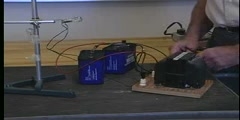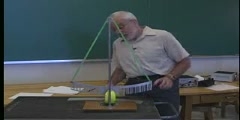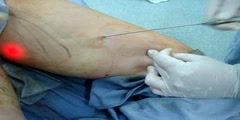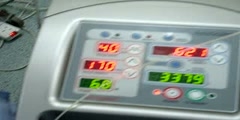Lec 22 - Physics 111: Laser Induced Fluorescence and Raman Scattering (LIF)
Physics 111: Laser Induced Fluorescence and Raman Scattering (LIF) Physics 111 Advanced Laboratory. Professor Sumner Davis This video accompanied the Laser Induced Fluorescence and Raman Scattering Experiment, providing students with an introduction to the theory, apparatus, and procedures. This experiment is no longer in use in the Physics 111 lab. Molecules in the gaseous state can absorb light when the frequency or photon energy matches the energy difference between two levels. A short time later, the molecules decay to lower energy states and emit photons (fluorescent light) with energies corresponding to energy differences between states. The lower states can be the same as or different from the original state. Observation of frequencies of light absorbed or of these fluorescence photons can tell us about the energy level structure of the molecule. In addition to absorption, molecules also scatter light no matter what its frequency. In this laboratory the techniques of absorption, laser induced fluorescence and scattering are used to study rotational, vibrational, and electronic energy levels of the ground and excited electronic states of diatomic molecular iodine, oxygen, and nitrogen. http://advancedlab.org
Video is embedded from external source so embedding is not available.
Video is embedded from external source so download is not available.
Channels: Physics (General)
Tags: Physics 111: Laser Induced Fluorescence and Raman Scattering (LIF)
Uploaded by: berkeleyphy111 ( Send Message ) on 19-09-2012.
Duration: 64m 43s
Here is the next lecture for this course
Lec 58 - Laser Induced Fluorescence
02:35 | 2678 viewsLec 7 - Physics 111: Carbon Dioxide Laser ...
31:31 | 4779 viewsLec 8 - Physics 111: Compton Scattering (COM)
20:27 | 3815 viewsLec 15 - Physics 111: Laser Safety
19:29 | 2637 viewsLec 34 - Physics 111: Rutherford Scatteri ...
27:50 | 4966 viewsPhysics Lab Demo 10: Induced Electromagne ...
01:37 | 16651 viewsLec 24 - Physics 111: Non-Linear Spectros ...
01:01:25 | 4159 viewsLec 25 - Physics 111: Non-Linear Spectros ...
34:46 | 3641 viewsPhysics Lab Demo 12: Eddy Currents
04:28 | 15143 viewsLec 11 - Physics 111: Holography (HOL)
26:23 | 3517 viewsLec 26 - Physics 111: Atom Trapping (MOT)
35:54 | 3701 viewsLec 33 - Physics 111: Optical Trapping (OTZ)
39:21 | 3055 viewsPhysics with Mr. Noon: Snell's Law
09:53 | 9373 viewsLaser creation body ima
02:02 | 19584 viewsLive laser liposuction by Hussein Saleh
00:37 | 15813 viewsNo content is added to this lecture.
This video is a part of a lecture series from of berkeley
Lecture list for this course
Lec 1 - Physics 111: Atomic Physics (ATM) Part 1. Balmer Series
Lec 2 - Physics 111: Atomic Physics (ATM) Part 2. Zeeman Effect
Lec 3 - Physics 111: Beta Ray Spectroscopy (BRA)
Lec 4 - Physics 111: Brownian Motion in Cells (BMC)
Lec 5 - Physics 111: Instrumentation Section Lab Equipment (BSC)
Lec 6 - Physics 111: Bubble Chamber (BBC)
Lec 7 - Physics 111: Carbon Dioxide Laser (CO2)
Lec 8 - Physics 111: Compton Scattering (COM)
Lec 9 - Physics 111: Gamma Ray Spectroscopy (GMA)
Lec 10 - Physics 111: Hall Effect In A Plasma (HAL)
Lec 11 - Physics 111: Holography (HOL)
Lec 12 - Physics 111: Introduction to Error Analysis
Lec 13 - Physics 111: Josephson Junction Effect (JOS)
Lec 14 - Physics 111: Radiation and Laboratory Safety
Lec 15 - Physics 111: Laser Safety
Lec 16 - Physics 111: Atomic Physics (ATM) Theory Lecture ONLY
Lec 17 - Physics 111: Energy Levels Lecture Part 1
Lec 18 - Physics 111: Energy Levels Lecture Part 2
Lec 19 - Physics 111 Light Sources and Detectors Lecture
Lec 20 - Physics 111: Optical Instruments Lecture
Lec 21 - Physics 111: Energy Transitions Lecture Series
Lec 23 - Physics 111: Low Light Signal Measurements (LLS)
Lec 24 - Physics 111: Non-Linear Spectroscopy and Magneto-Optics Part 1 (MNO)
Lec 25 - Physics 111: Non-Linear Spectroscopy and Magneto-Optics Part 2 (MNO)
Lec 26 - Physics 111: Atom Trapping (MOT)
Lec 27 - Physics 111: Muon Lifetime (MUO)
Lec 28 - Physics 111: Non-Linear Dynamics and Chaos (NLD)
Lec 29 - Physics 111: Nuclear Magnetic Resonance (NMR) Part-1 Continuous Wave
Lec 30 - Physics 111: Nuclear Magnetic Resonance Part-2 Pulsed NMR
Lec 31 - Physics 111: Optical Pumping (OPT)
Lec 32 - Physics 111: How to do an Oral Report
Lec 33 - Physics 111: Optical Trapping (OTZ)
Lec 34 - Physics 111: Rutherford Scattering (RUT)
Lec 35 - Physics 111: Hall Effect In A Semiconductor
















